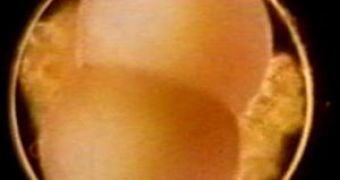Studies performed on the world's oldest embryos revealed the first direct evidence that primitive animals dated 635 to 550 million years ago presented primitive and some very evolved traits in embryonic development.
These fossilized embryos predate the Cambrian Explosion and the earliest conclusive evidence of bilateral symmetry in trace fossils. "We're learning something about how the very earliest multicellular animals formed embryos and how the embryos developed," said IU Bloomington biologist Rudolf Raff.
The analysis showed that the fossil embryos had already used the style of cell division used by modern embryos. 162 "relatively pristine" animal embryo fossils were found in 1998 on Doushantou formation of South China. The embryos were fossilized in exquisite detail, showing stages of successive cell division.
However, the age of the fossils is uncertain and there was not discovered a succession of fossils leading to adult animals. The embryos were still wrapped in a fertilization envelope, like protective shell that aided the preservation of the embryos long enough for fossilization to occur.
To inspect the fossils' surfaces and even innards, the scientists used X-ray computed tomography, scanning electron microscopy, transmission electron microscopy and thin-section petrography, amongst other techniques. "Some embryos contained the exact numbers expected if the cells had all divided the same number of times - 2, 4, 8, 16, and 32. But others contained slightly more or fewer. Genetic control systems in modern embryos cause cells to divide at different rates so the animal can develop towards its final structure: the uneven counts in the ancient embryos show they had evolved a similar mechanism," says Shuhai Xiao of the Virginia Polytechnic Institute, US.
Unfortunately, once an embryo's development takes it beyond 16 cells, an increasing number of cells are concealed inside. That made accurate cell counting possible only when all cells were exposed on the surface.
Electron micrography of internal structures such as embryonic lipid vesicles in modern embryos served as the key comparisons with structures observed in the fossil embryos, and pointed on the asynchronous cell division during embryonic development. Asynchronous cell division allows the formation of unique shapes and appearance of specialized tissues. The scans also showed differences in mineralization within the cells, which he says could be organelles and cell nuclei undergoing division.
Two main traits present in modern embryos were not found even in the fossils containing 1000 or more cells: an epithelium (an outer layer of cells) and a blastocoel (a fluid-filled gap in the middle of the embryo and a common feature among modern animal embryos). Thus, the embryos came from animals more primitive than any living multicellular type, including sponges and jellyfish. "Either these embryos are primitive and don't have a clear blastocoel, or a blastocoel existed but didn't survive the preservation process." said Raff.
This contradicts the results of a previous study that concluded some of the fossils were primitive animals that exhibited bilateral symmetry, a key evolutionary development.
Janmes Hagadorn of Amherst College says that the few fossils which looked bilateral had been damaged, and insists that embryos with advanced symmetry are unlikely to have appeared during the time of these fossilized embryos. Until only recently, many paleontologists doubted claims that fossilized embryos hundreds of millions of years old could exist.
The present analysis of fossilized embryos rejects any doubt about the existence of these extremely old embryos. And fossilized embryos are very rare. Intact fossil embryos are even rarer.

 14 DAY TRIAL //
14 DAY TRIAL //